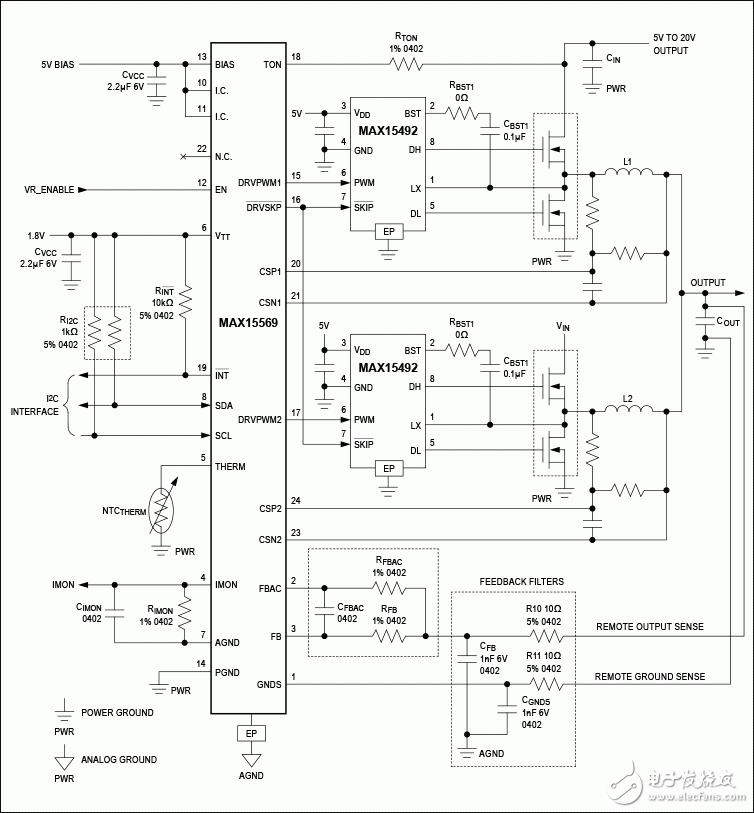The MAX15569 step-down controller consists of a multiphase regulator. The multiphase CPU regulator uses Maxim's unique 2-phase QuickTune-PWM constant "on-time" architecture. The two-phase CPU regulator runs 180° out of phase for true interleaved operation, minimizing input capacitance.
The device's VR control writes the appropriate data into a function-mapped register file. Dynamic changes in output voltage are fast via a 2-wire I²C interface (clock, data), allowing the switching regulator to be programmed to accommodate different voltages. A slew rate controller allows for controlled voltage transitions and controlled soft-start. The regulator operates on a unique intelligent, low-power pulse-skipping algorithm for efficiency and best transient response over the entire load range, compared to common pulse-skipping methods.
The device includes multiple fault protection functions: output overvoltage protection (OVP), undervoltage protection (UVP), and thermal protection. When these fault protection functions detect a fault condition, the controller shuts down. The multi-function active-low INT output monitors the output voltage, overcurrent (OC), overrange (VOUTMAX), and thermal fault (active-low VRHOT).
The controller features a programmable switching frequency, allowing operation from 300kHz to 1400kHz per phase. The controller works with a wide variety of drivers and MOSFETs, such as the MAX15492 MOSFET driver with standard MOSFETs, or with the power stage driver and MOSFET integrated in a single device.
Key Features
2-Phase QuickTune-PWM CPU Core Voltage Regulator
Transient phase overlap reduces output capacitance
I²C serial interface control
Output voltage control
System Status Register
Current Monitor Register
Multi-function output low level effective INT
Overcurrent, output voltage overrange, overvoltage, undervoltage and thermal fault protection
±5mV FB Accuracy at Line and Load
7-bit DAC (0.5V to 1.6V, 10mV/LSB)
True differential remote output sensing
Active load line with adjustable gain
Precise current balancing and current limiting
4.5V to 24V Battery Input Voltage Range
Programmable 300kHz to 1400kHz Switching Frequency
Programmable slew rate and soft-start
chart

Typical Application Circuit (with MAX15492 Driver and MOSFET)
Previous article:MAX24011 2.5Gbps Transimpedance Amplifier
Next article:NIST develops MEMS delay line memory controller
- High signal-to-noise ratio MEMS microphone drives artificial intelligence interaction
- Advantages of using a differential-to-single-ended RF amplifier in a transmit signal chain design
- ON Semiconductor CEO Appears at Munich Electronica Show and Launches Treo Platform
- ON Semiconductor Launches Industry-Leading Analog and Mixed-Signal Platform
- Analog Devices ADAQ7767-1 μModule DAQ Solution for Rapid Development of Precision Data Acquisition Systems Now Available at Mouser
- Domestic high-precision, high-speed ADC chips are on the rise
- Microcontrollers that combine Hi-Fi, intelligence and USB multi-channel features – ushering in a new era of digital audio
- Using capacitive PGA, Naxin Micro launches high-precision multi-channel 24/16-bit Δ-Σ ADC
- Fully Differential Amplifier Provides High Voltage, Low Noise Signals for Precision Data Acquisition Signal Chain
- Innolux's intelligent steer-by-wire solution makes cars smarter and safer
- 8051 MCU - Parity Check
- How to efficiently balance the sensitivity of tactile sensing interfaces
- What should I do if the servo motor shakes? What causes the servo motor to shake quickly?
- 【Brushless Motor】Analysis of three-phase BLDC motor and sharing of two popular development boards
- Midea Industrial Technology's subsidiaries Clou Electronics and Hekang New Energy jointly appeared at the Munich Battery Energy Storage Exhibition and Solar Energy Exhibition
- Guoxin Sichen | Application of ferroelectric memory PB85RS2MC in power battery management, with a capacity of 2M
- Analysis of common faults of frequency converter
- In a head-on competition with Qualcomm, what kind of cockpit products has Intel come up with?
- Dalian Rongke's all-vanadium liquid flow battery energy storage equipment industrialization project has entered the sprint stage before production
- Allegro MicroSystems Introduces Advanced Magnetic and Inductive Position Sensing Solutions at Electronica 2024
- Car key in the left hand, liveness detection radar in the right hand, UWB is imperative for cars!
- After a decade of rapid development, domestic CIS has entered the market
- Aegis Dagger Battery + Thor EM-i Super Hybrid, Geely New Energy has thrown out two "king bombs"
- A brief discussion on functional safety - fault, error, and failure
- In the smart car 2.0 cycle, these core industry chains are facing major opportunities!
- The United States and Japan are developing new batteries. CATL faces challenges? How should China's new energy battery industry respond?
- Murata launches high-precision 6-axis inertial sensor for automobiles
- Ford patents pre-charge alarm to help save costs and respond to emergencies
- New real-time microcontroller system from Texas Instruments enables smarter processing in automotive and industrial applications
- What are thin AP, fat AP, AP+AC, and Mesh?
- Bluenrg_Why can't I add my own services or characteristics?
- How connected vehicles process data: 3 common questions
- [Jihai APM32E103VET6S development board] Evaluation 2, Development environment
- [EVK-NINA-B400 Evaluation Kit] + First Meeting
- msp430 LCD driver module
- EEWORLD University Hall----Combining buck-boost topology and USB Type C? Power Delivery to achieve maximum power density
- How to use high-speed ADCs and DACs with FPGAs
- 618 What did you buy?
- Vicor's better power supply increases drone flight time, radius and payload

 Raspberry Pi Development in Action (2nd Edition) ([UK] Simon Monk)
Raspberry Pi Development in Action (2nd Edition) ([UK] Simon Monk) 開關電源專業英語
開關電源專業英語
















 京公网安备 11010802033920号
京公网安备 11010802033920号